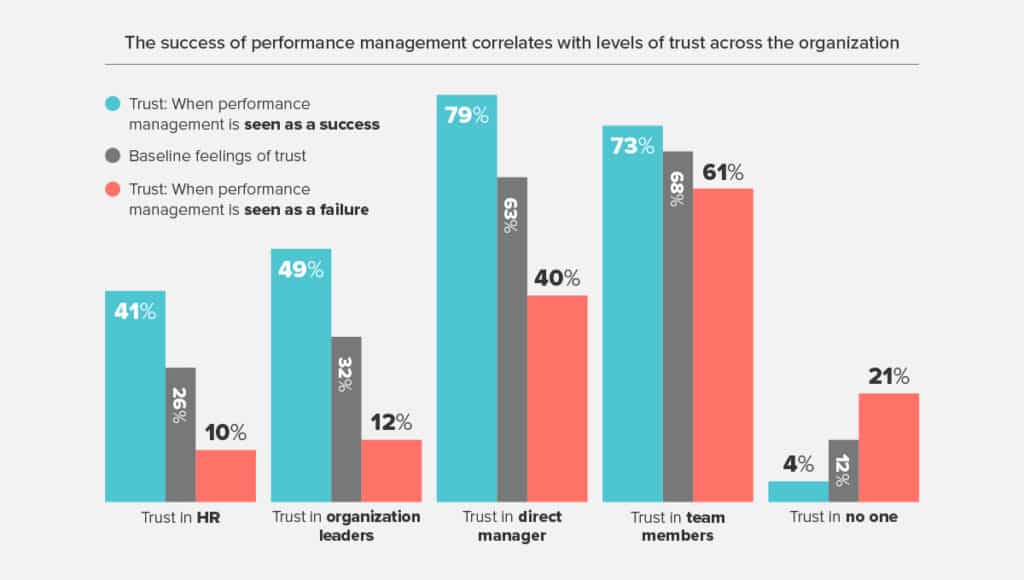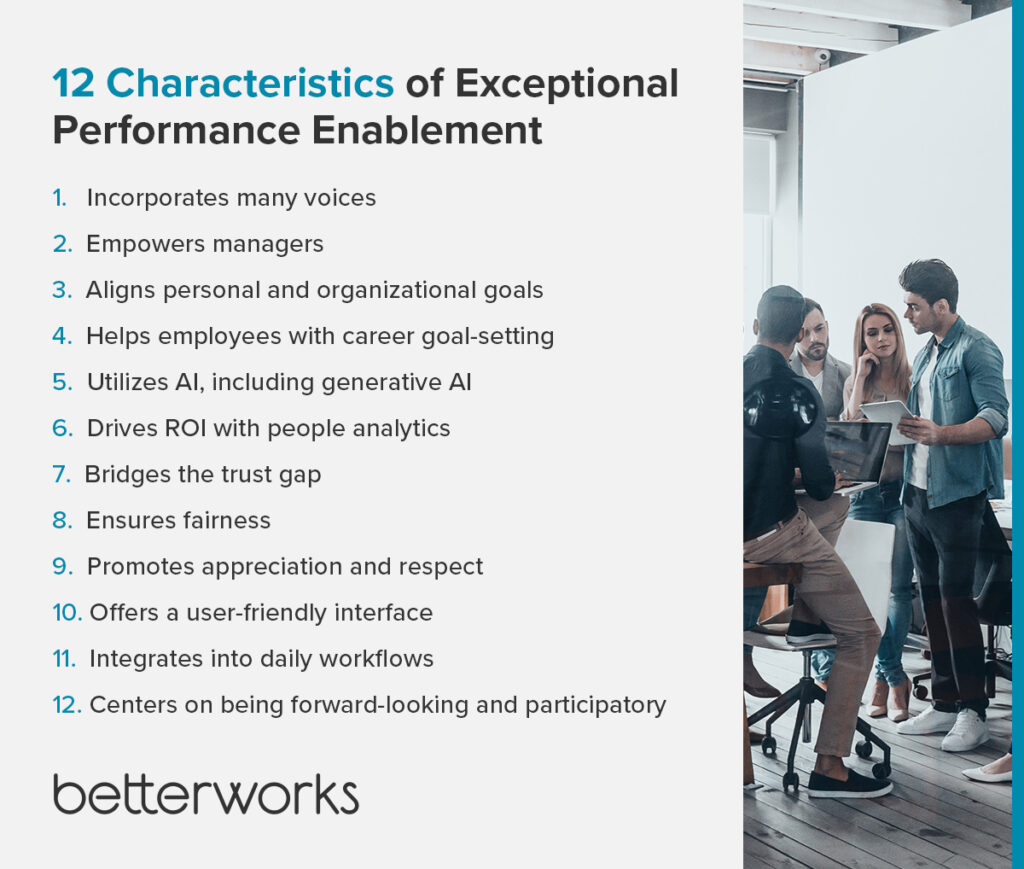In a competitive business landscape, organizations are keen on employee experience metrics like engagement, productivity, and retention. They serve as signals of whether a company is maximizing business outcomes with its workforce. But, according to the Betterworks 2023 State of Performance Enablement report, the key to delivering on these metrics requires fostering underlying sentiments such as trust, belonging, inclusion, fairness, and confidence that are the foundation for elevating employee experience. While there is no magic elixir that can create this utopia, research shows that having the right approach to performance management has a multiplier effect on organizations, yielding the higher engagement, productivity, and retention they value by improving how employees experience work day in and day out.
The Multiplier Effect of Performance Management shows the link between employee experience sentiments and the impact of performance enablement on them. Using data drawn from the Betterworks 2023 survey, this latest research underscores how the focus of modern performance management — meaningful manager-employee conversations, manager and employee feedback, agile performance and goal-setting, and recognition in the flow of work — influences and connects the dots between employee sentiments such as trust, fairness, satisfaction, inclusion, confidence, optimism, and resilience. These elements don’t just play a superficial role; they lie at the core of the employee experience.
Employee Experience Metrics — More Important Than Ever
Consider just three aspects — albeit significant ones — of employee experience: trust, fairness, and belonging.
According to Gallup, only 21% of U.S. employees strongly agree that they trust leadership in their organization, even lower than what Betterworks found in this year’s research (32% trust leadership). Without trust, it is impossible to achieve strong performance. Employees expect transparency and clear communications from leadership, including their managers, and need clarity about what leaders expect of them. Betterworks’ research shows that when employees are satisfied with their performance and career conversations with their managers, and when they feel their company’s performance management is a success, they have high levels of trust and confidence.
Fairness is closely associated with trust. Perceptions of fairness are affected by a multitude of factors, including DEI, pay and compensation structures, hybrid and in-office work policies, and performance management, to name just a few. When Gartner interviewed 3,500 employees worldwide in 2021, only 18% indicated they worked in a “high-fairness” environment. Betterworks 2023 survey showed that trust actually plummeted among employees who felt performance management practices were unfair (and skyrocketed by 2x-4x when they felt performance management was fair). Gartner found that what moved the needle on perceptions of unfairness were experiences that happen in daily work. Performance enablement is an approach that guides daily interactions and activities.

A sense of belonging is a key sentiment that affects how employees feel about themselves and their colleagues — and has a tremendous bottom-line impact. Research by BetterUp found that a feeling of high belonging led to a 56% increase in job performance, a 50% drop in turnover risk, and a 75% percent reduction in sick days. For a 10,000-person company, BetterUp calculated an annual savings of more than $52 million.
Betterworks found that fewer than 2 in 5 employees always feel a sense of belonging and value at work, but that satisfaction with manager conversations around performance boosts employees’ feeling of belonging. Nearly two-thirds of employees who felt valued at work reported they were always satisfied with their manager conversations around performance. That percentage dropped to 55% among employees who were sometimes satisfied with manager conversations and 47% among employees who were rarely satisfied with such dicussions.
Performance enablement: the heart of enhanced employee experiences
Performance enablement, an innovative and human-centric approach to performance management places these and other employee sentiments front and center and is a big lever organizations can push to improve and even transform company culture. When implemented correctly, performance enablement can be a game-changer for enterprises, resulting in a multiplier effect that extends far beyond typical key performance indicators.
Traditional performance management relies on backward-looking assessments in the form of annual or semi-annual reviews, and structured feedback cycles. This approach fails to help employees “in the moment” and continuously, two aspects that can vastly improve employee effectiveness.
Employees often see performance management as a command-and-control exercise rather than one that helps them improve, which should be the intent. It also opens managers and employees to recency bias when it comes to reviewing an employee’s body of work. Unconscious bias may also creep into performance reviews if regular peer feedback is not incorporated, leading to lowered trust.
Performance enablement shifts the paradigm. It aims to strengthen the emotional and intellectual connection employees have with their work, acting as a launchpad for driving better performance and optimizing employee effectiveness. Instead of focusing solely on results, this approach dives deeper, helping employees connect with their colleagues and work emotionally and intellectually.
By understanding and reinforcing positive sentiments, organizations can redefine how employees perceive their roles, the purpose behind their roles, and their place within the organizational structure. This deeper connection with work, combined with a solid sense of belonging and purpose, serves as a powerful springboard for driving performance metrics.
Why evolve performance management systems?
It’s evident that businesses are catching on to the need for a revamped performance management strategy. Betterworks research shows that post-2020, 46% of employees have seen their companies roll out new performance management systems. Yet, intention doesn’t always translate to success.
A staggering 37% of employees in the Betterworks study graded their performance management systems as falling short. This isn’t a reflection of resistance to change but rather an indicator that the change introduced might not be in the right direction. The challenge isn’t just to introduce new systems but to ensure they resonate with what employees truly value and desire.
The right kind of performance management matters. Sticking with an inadequate approach can be costly — even greater than the cost of implementing a new solution. A performance management system that undermines trust, fairness, and other key workplace sentiments can lead to lower productivity, higher employee turnover, and contribute to a poor culture that is reflected in lower eNPS and employer brand.
Dedicated performance management systems that promote rich relationships and purposeful conversations and feedback in the flow of work, and place emphasis on action, achievement, and accountability are better received and adopted by employees. Why? Because they provide real value and benefit. Higher adoption, in turn, enables enterprises to collect and analyze rich contextual data that drives better decision-making and organizational outcomes.
Characteristics of exceptional performance enablement
Companies must embrace a more holistic performance enablement mindset that starts not with productivity and engagement, but with the factors that contribute to those outcomes. In Betterworks’ 12 Qualities that Make Performance Enablement Exceptional checklist, we detail the qualities that organizations should use as a barometer for evaluating their approach and technology and the supporting data. In brief, they are:
- Incorporates many voices: Prioritizes inclusion by involving various perspectives and feedback in performance evaluations.
- Empowers managers: Equips managers with tools and guidelines to foster trust and transparency within their teams.
- Aligns personal and organizational goals: Helps employees see how their individual tasks contribute to broader company objectives.
- Helps employees with career goal-setting: Facilitates conversations about personal career growth and skill development.
- Utilizes AI, including generative AI: Incorporates AI to simplify tasks like goal-setting and to offer unbiased feedback.
- Drives ROI with people analytics: Uses data analytics to inform decisions on performance management, DEIB, and other areas.
- Bridges the trust gap: Addresses the disparity in trust levels between employees, managers, and leadership.
- Ensures fairness: Aims for a fair and unbiased performance evaluation process and calibration process.
- Promotes appreciation and respect: Includes ways for managers and peers to recognize and appreciate good work.
- Offers a user-friendly interface: Prioritizes an intuitive, easy-to-navigate user experience to encourage adoption and deliver rich data.
- Integrates into daily workflows: Is designed to fit seamlessly into daily tasks in the flow of work and is scalable to accommodate future growth.
- Centers on being forward-looking and participatory: Focuses on continuous improvement and frequent feedback, and allows for customization to meet organizational needs.

Adopting a performance enablement mindset and establishing performance enablement that embraces these twelve qualities can significantly enhance an organization’s overall performance and deliver an employee experience that will drive engagement, productivity, and retention.
The Multiplier Effect of Performance Enablement






